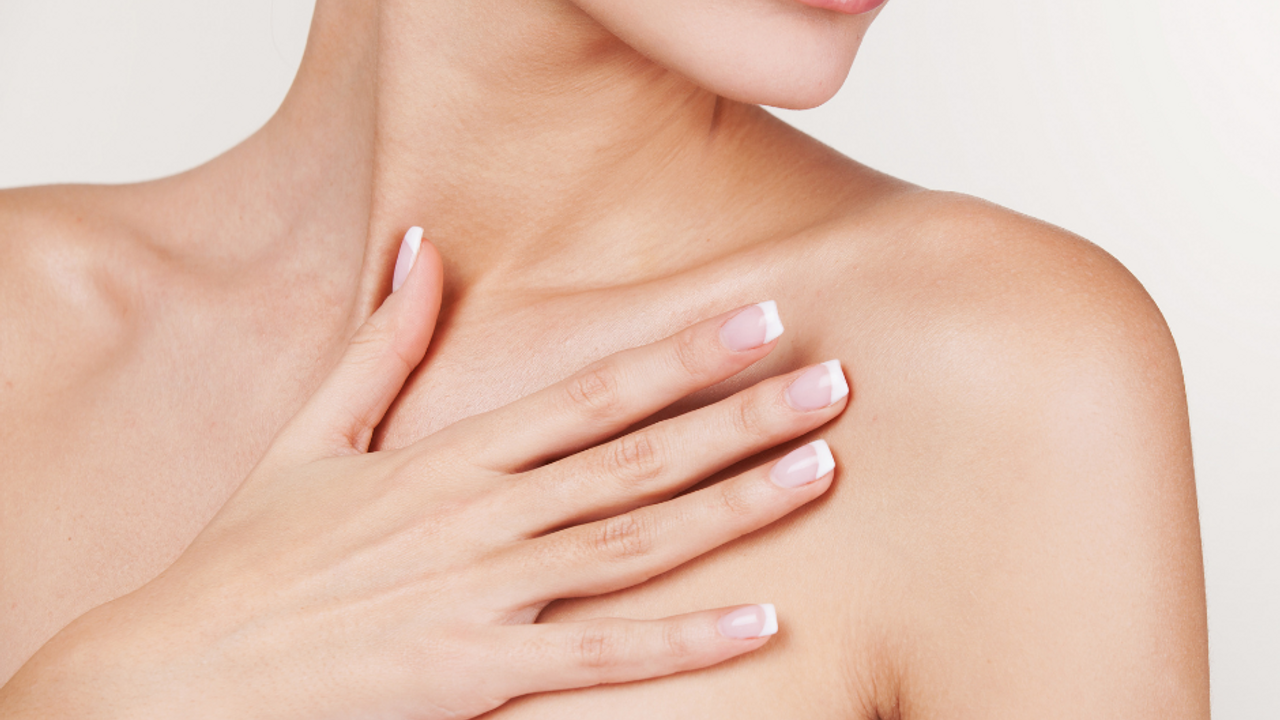Perimenopause and Your Changing Skin
Jun 16, 2021
If you’re in perimenopause or postmenopause, you may notice your skin become dry, thin, dull, and more easily bruised or prone to redness, while age spots, lines, and wrinkles start to become more noticeable.
You may even have blemishes pop up unexpectedly.
Or you get catch a random chin hair popping up while looking in the mirror.
During the phases of menopause, your skin undergoes dramatic changes as hormone levels fluctuate.
For some women, that change can feel like it happens overnight.
Did you know: The biggest changes in your skin over your lifetime occurs during your menopause journey? Skin regeneration and repair slow down significantly while aging accelerates.
Aging skin suffers from a loss of natural lipids, like ceramides, fatty acids, and cholesterol, which contributes to inflammation, dehydration, and a compromised moisture barrier.
During menopause, the skincare routine and products we’ve relied on for years to keep our skin looking healthy stop working effectively and don’t address the skin issues that start cropping up.
You may notice a dramatic swing it your skin type (like oily to dry) making your current skincare routine pointless.
To help you make the transition to a new skincare routine, I want to share tips I've learned from Lisa Health on caring for our skin during perimenopause and beyond.
Dry, Dull Skin - During menopause, skin loses some ability to hold water, and there is a decrease in natural oils and collagen, causing thinner, dryer skin that looks dull. Don’t use soap, especially deodorant soap to cleanse your face. It’s too drying. Use a gentle cleanser.
Apply a moisturizer with hyaluronic acid after washing your face. Hyaluronic acid holds 1,000 times its own weight in water. It draws in moisture so is ideal for hydrating the skin and giving you back your glow.
Use a gentle exfoliation product once or twice a week to keep your pores clear of dead skin cells.
Get a regular facial. Find an esthetician that understands the unique needs of menopausal skin.
If professional facials are not in your budget, practice this 7-step regimen at home every 2-3 weeks to get some of the same benefits of a professional facial.
-
Cleanse your skin with a gentle face wash. Even if you are not wearing makeup wash your skin to remove accumulated dirt and pollution.
-
Exfoliate with a gentle exfoliation product. Don’t rub too hard.
-
Steam your skin with a clean washcloth run under very hot water, taking care not to burn your skin. Leave the cloth on your skin for a few minutes.
-
Apply a clay mask to cleanse the pores and remove impurities. If your skin is very dry and not acne prone skip the clay mask as it may be over drying.
-
Repeat the steaming-washcloth routine to remove the mask.
-
Apply a hydrating mask for dry skin or a brightening mask for dull skin and rinse it off with cool water.
-
Finish by applying a moisturizer. If you are going to go out in the sun, make sure it has an SPF of at least 30.
Fine Lines, Wrinkles, Slack Skin - The skin stays plump in large part due to collagen, which we lose quickly during menopause. The skin starts to sag and wrinkles become more prominent.
Protect your skin from the sun. Use a moisturizer with a broad spectrum SPF of 30 or higher every day. Don’t forget to protect your neck and chest. During the summer months, wear a broad-brimmed hat for extra protection.
Avoid tanning in the sun or using a tanning bed. It will only accelerate the aging process and further damage the skin.
Use a moisturizer every day to trap water in the skin, brighten your skin, and make lines less visible.
Try a serum to further hydrate and re-densify the skin.
Blemishes - Hormone fluctuations are frequently to blame for breakouts although certain foods and product ingredients can also make you break out. Your body changes during menopause and foods and products that you once tolerated may be causing acne.
Some makeup along with many skin and hair care products contain oil or other ingredients that can cause acne breakouts. If you continue to use them, you may continue to see blemishes.
Stay aware from common pore clogging ingredients in hair products, including sodium lauryl sulfate, sodium coco sulfate, and sodium laureth sulfate.
Certain foods can cause breakouts. Try an elimination diet and see how your skin responds. The shortlist of potential acne causing foods includes:
Dairy (includes whey protein shakes), Soy (includes soy protein shakes), Peanuts (includes peanut oil and peanut butter), High glycemic foods/high sugar (white refined grains/breads/carbs, alcohol/beer, sweets, sodas), High sodium/salty processed food (fast food, pizza, cured deli meat, packaged foods), Iodine (includes iodized salt, spirulina, kelp, seaweed, carrageenan, chlorella), High amounts of caffeine (boba, coffee drinks, pre-workout shakes, energy drinks)
Other lifestyle factors can cause blemishes. Make sure you get plenty of sleep on a regular schedule.
Lower your stress levels with daily self-care activities. Don’t touch your cell phone to your cheek.
Wash your pillowcases at least once a week. Forgo fabric softener, including dryer sheets and fragranced detergent.
Supplements that may help with acne include fish oil, probiotics, and zinc. Make sure the brand is of high quality.
Don’t over dry your skin through aggressive washing or product application. It may make the problem worse.
Something you should already know by your age, but don’t sleep in your makeup and wash your makeup brushes and applicators frequently.
Cleanse your skin post-workout or after any activity that causes you to sweat. Don’t forget to reapply sunscreen if you will be outside.
Red, Irritated Skin - Around 50, the pH level of our skin changes. With this change, skin becomes more sensitive, and women are more likely to develop rashes and easily irritated skin. Women may also notice that they are more sensitive to itchy fabrics, soaps, or beauty products.
Don’t use too many products at once and introduce one new product at a time. For most of us, a simple skincare routine is best. Test the products on the back of your hand or arm if you are particularly sensitive.
Avoid any products with fragrance.
Wear clothing and use bedding made from natural fibers like cotton and silk that allow your skin to breath.
See a dermatologist for any suspicious or persistent skin irritations.
Age Spots - Age spots are the little brown spots that we start to notice on our face, chest, and the back of our hands, although they can appear anywhere on the body. People with lighter skin tend to get them more along with people who have had prolonged exposure to the sun or used a tanning bed earlier in life.
Creams and lotions are available that can help lighten brown spots, but be prepared to apply the product daily for 6-12 weeks before you notice a difference. Also, make sure that the product you select doesn’t contain any harmful ingredients like mercury.
Various treatments administered by a board-certified dermatologist work faster. However, they cost more, and there are potential side effects. Even with treatment, age spots can return so it’s important to avoid the sun after investing in one of these procedures.
Laser therapy typically entails one or two sessions and results can longer than creams and lotions.
Cryotherapy entails freezing the age spot. As the skin heals, it looks lighter.
Microdermabrasion is when the dermatologist smooths away the age spots. You might have mild redness or flaky skin that goes away.
Chemical peeling involves brushing a chemical solution onto the skin to exfoliate it, then peeling away the dead cells.
Protect your skin from the sun. Use a moisturizer with a broad spectrum SPF of 30 or higher every day on your face, neck, and chest.
4 sunscreen ingredients to avoid
- Oxybenzone -- filters UV rays from the sun, but in the body, can mimic estrogen, interfere with testosterone production and disrupt adrenal hormones.
- Octinoxate -- the most widely used UVB-absorbing agent in sunscreen today, octinoxate produces estrogen-like activity and may also target thyroid function.
- Homosalate -- is another common UVB-absorbing chemical that acts as an estrogen in the body. Do you slather on sunscreen and douse yourself in bug spray at the same time? Studies show that homosalate increases the amount of pesticides we absorb through the skin -- allowing in even more toxins.
- Parabens -- are endocrine-disrupting synthetic preservatives found in cosmetics and body care products, including conventional sunscreens. Parabens can be tricky to find on labels. Look for ingredient names like methylparaben, propylparaben, isoparaben or butylparaben.
What looks like an age spot could be skin cancer. Get a skin cancer check at least once a year and anytime you notice a suspicious mark on your skin.
Adapting your skincare routine is an important part of caring for aging skin, but there are other aspects of our lifestyle that play a vital part in helping us get and keep that lovely glow.
-
Less is always more. Don’t pile on the makeup. It only makes you look older. In fact, not only do you need to change your skincare routine as you age, but your makeup routine and products need an overhaul as well. Confidence, good health, and joy beats makeup hands down. Be comfortable in your own skin sans makeup, and lower your personal toxins while you’re at it.
-
Manage your stress levels. Stress and anxiety can trigger or worsen a variety of skin conditions.
-
Sleep well.
-
Eat healthfully. A diet rich in plants and phytoestrogens like flaxseeds and soy can have hormone balancing effects and help with hot flashes as well as overall health.
What's one thing you've noticed that’s difference about your skin after 40?
Stay connected with news and updates!
Join our mailing list to receive the latest news and updates from our team.
Don't worry, your information will not be shared.
We hate SPAM. We will never sell your information, for any reason.


